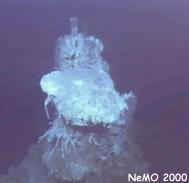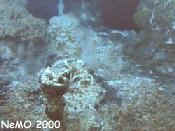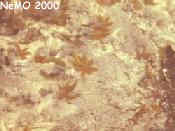| |
Teacher
Logbook:
Friday, July 14, 2000 1600
hrs.
Today we're diving in an
area called ASHES. The superheated fluids flowing from the ASHES vent
field receive their heat from a magma chamber about 2 km below Axial.
The chamber and Axial owe their existence to the fire within our planet
that geologists have only recently come to understand. They must infer
the process occurring in Earth's interior through seismic (earthquake)
waves and the surface expressions, or features that compose the crust
of the Earth. Inference into these processes is not a recent pursuit.
Throughout history many have attempted to explain such questions as why
there are continents scattered throughout our global ocean. Through a
range of geological studies people worked toward a better understanding
of the Earth but it wasn't until the 20th century that the various disciplines
of geology were tied together.
In 1912 a scientist named
Alfred Wegener proposed a theory for some observations he, and others
made. A map of the Atlantic Ocean shows Africa and South America as two
pieces of a jigsaw puzzle pulled apart. He stated, citing fossil and glacial
evidence, that these two continents were once together. In fact all the
contintents were connected at one time as a giant supercontinent surrounded
by an ocean. This landmass, Pangaea, split up about 200,000,000 years
ago and the continents drifted to their current positions where they continue
to drift today. Most geologists at the time rejected this radical idea
of continental drift. In 1940 Hugo Benioff used seismic data to plot earthquake
and volcanic activity on a map. He found a pattern of activity around
the Pacific Ocean now known as the Pacific Ring of Fire. Later, studies
of what we now know as oceanic ridges were conducted. It was found that
oceanic plates are born along these ridges and become older as one moves
away from either side of a ridge. The seafloor spreading theory was born.
Later still, subduction zones were described as regions where plates were
destroyed as they descended into Earth's interior.
Finally, in 1965 J. Tuzo
Wilson combined continental drift and seafloor spreading into the most
powerful concept that geologists use today. Termed plate tectonics, this
theory states that Earth's outer layer consists of about a dozen separate
plates that float on a layer below them. With heat-driven movement from
the Earth's interior the gigantic plates are dragged, and over millions
of years they may move significant distances. Most of the million or so
earthquakes and volcanic events each year occur along the boundaries between
these plates. Axial Volcano, along the Juan de Fuca Ridge, is at the boundary
of the Pacific Plate and the Juan de Fuca plate. Here, oceanic crust is
born. It will travel some 250 miles and then descend below the North American
plate. As a result of this subduction process, the Coast Ranges of Oregon
and Washington, the Olympics, and Cascades Mountains were created. Therefore,
plate tectonics ties Axial Volcano to the volcanoes of the Pacific Northwest:
St. Helens, Rainier, Hood, Shasta, etc.
Jeff
|
|

Mushroom Vent in the ASHES
vent field.

Hell Vent at ASHES.

Sulfide worms under Pork Chop, a flange of Hell Vent.
|
|

